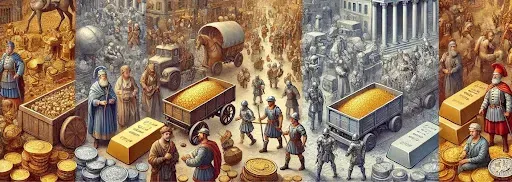
Precious metals have played a crucial role in shaping human history and the development of economies. Gold, silver, and other precious metals have been used as currency, store of value, and symbols of wealth and power for thousands of years. Their impact on historical economies is profound, influencing trade, politics, and societal structures. This article explores the role of precious metals in historical economies, tracing their journey from ancient civilizations to the modern era.
Ancient Civilizations and the Birth of Monetary Systems
The earliest known use of precious metals dates back to ancient Mesopotamia, around 3000 BCE. The Sumerians, one of the earliest civilizations, used silver as a medium of exchange. This was not in the form of coins but rather as ingots and rings. Silver’s intrinsic value, due to its rarity and desirability, made it a reliable store of value and medium of exchange.
In ancient Egypt, gold played a significant role in the economy and culture. The Egyptians were among the first to mine gold extensively, with the precious metal being used for trade, jewelry, and religious artifacts. Gold was considered the flesh of the gods, particularly the sun god Ra, and was thus held in high esteem. The wealth of Egypt, partly derived from its gold resources, allowed it to become one of the most powerful civilizations of its time.
The Rise of Coinage and Classical Economies
The invention of coinage in the 7th century BCE by the Lydians in modern-day Turkey revolutionized economies. Coins made from precious metals like gold, silver, and electrum (a natural alloy of gold and silver) standardized transactions, facilitating trade both locally and across regions. The use of coins spread rapidly throughout the ancient world, with Greek and Roman economies adopting and refining the practice.
In Greece, silver coins from the Laurium mines near Athens became the standard currency, fueling the city-state’s economy and helping it finance monumental projects such as the Parthenon. The Athenian economy thrived on trade, supported by its powerful navy, which protected merchant ships carrying precious metals and other goods.
The Roman Empire took coinage to new heights, minting coins in gold (aureus), silver (denarius), and bronze (sestertius). The stability and vast reach of the Roman economy were partly due to its control over precious metal resources and its sophisticated monetary system. The Romans used precious metals not only for currency but also as a means to display wealth and power, with emperors often depicted on coins to reinforce their authority.
Medieval Economies and the Role of Silver and Gold
During the medieval period, the importance of precious metals in economies continued. Silver was particularly significant in Europe, with large deposits being mined in Germany, Austria, and later in the Americas. The silver from these mines became the backbone of medieval economies, with coins like the German thaler becoming widespread.
Gold also remained crucial, especially in the Byzantine Empire, where the gold solidus (or bezant) became a standard for trade across Europe and the Mediterranean. The stability of the Byzantine currency system helped maintain trade and economic stability in a period often characterized by political fragmentation and upheaval.
The discovery of vast silver and gold deposits in the New World during the Age of Exploration dramatically shifted global economies. Spanish conquests in the Americas led to the extraction of immense quantities of silver, particularly from the Potosí mines in present-day Bolivia. This influx of precious metals into Europe fueled economic growth but also contributed to inflation, a phenomenon known as the Price Revolution.
The Modern Era: Precious Metals and Financial Systems
In the modern era, precious metals continue to play a vital role in economies. The gold standard, established in the 19th century, linked the value of national currencies to a specific amount of gold. This system provided stability and facilitated international trade by ensuring that currencies had a predictable value. However, the gold standard also had limitations, such as restricting the ability of governments to respond to economic crises by adjusting the money supply.
The abandonment of the gold standard in the 20th century marked a significant shift in the role of precious metals. Currencies became fiat money, not backed by physical commodities, but precious metals retained their importance as a store of value and hedge against inflation. Gold, in particular, is still held by central banks and investors as a safeguard against economic instability.
Conclusion
The role of precious metals in historical economies is a testament to their enduring value and significance. From ancient Mesopotamia to modern financial systems, gold, silver, and other precious metals have been integral to trade, economic stability, and the display of wealth and power. Their journey through history underscores their unique position as both a commodity and a symbol of enduring value. As we navigate the complexities of modern economies, the lessons from history remind us of the pivotal role that precious metals continue to play in shaping our economic landscape.
Another article that may interest you:
The History and Significance of High-Denomination U.S. Currency
